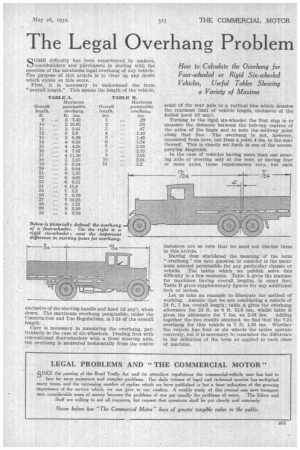• The Legal Overhang Problem
Page 49

If you've noticed an error in this article please click here to report it so we can fix it.
How to Calculate the Overhang for Four-wheeled or Rigid Six-wheeled Vehicles. Useful Tables Showing a Variety of Maxima SOMH difficulty has been experienced by makers, oachhuilders and purchasers in dealing with the question of the maximum legal overhang of any vehicle. The purpose of this article is to clear up any doubt which exists on this score.
First, it is necessary to understand the term "overall length." This means the length of the vehicle, exclusive of the starting handle and hood (if any), when down. The maximum overhang permissible, under the Construction and Use Regulations, is 7-24 of the overall length.
Care is necessary in measuring the overhang, particularly in the ease of six-wheelers. Dealing first with conventional four-wheelers with a front steering axle, the overhang is measured horizontally from the centre point of the rear axle to a vertical line which denotes the rearmost limit of vehicle length, exclusive of the folded hood (if any).
Turning to the rigid six-wheeler the first step is to measure the distance between the hub-cap centres of the axles of the bogie and to note the.-midway point along that line. The overhang is not, however, measured from here, but from a point 4 ins, to the rear thereof. This is clearly set forth in one of the accompanying diagrams.
In the case of vehicles having more than one steering axle or steering only at the rear, or having four or more axles, these requirements vary, but such instances are so rare that we need not discuss them in this article.
Having thus elucidated the meaning of the term "overhang," the next question to consider is the maximum amount permissible for any particular chassis or vehicle. The tables which we publish solve this difficulty in a few moments. Table A gives the maxima for machines having overall lengths, in exact feet. Table 13 gives supplementary figures for any additional inch or inches.
Let us take an example to illustrate the method of working. Assume that we are considering a vehicle of 24 ft. 7 ins, overall length ; table A gives the overhang allowance for.. 24 ft. as 6 ft. 11.8 ins., whilst table B gives the allowance for 7 ins. as 2.03 ins. Adding together the two results obtained, we find that the 7-24 overhang for this vehicle is 7 ft. 1.83 ins. Whether the vehicle has four or six wheels the tables operate correctly, but it is necessary to remember the difference in the definition of the term as applied to each class of machine.




































































































